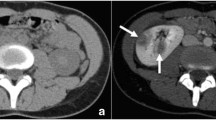Abstract
Purpose
The purpose of this study was to evaluate whether hepatic periportal tracking (PPT) in patients with acute pyelonephritis correlates with the severity of pyelonephritis.
Material and methods
A database search was conducted of patients with clinically suspected acute pyelonephritis who underwent abdominal computed tomography (CT) between January 2004 and June 2009 for disease evaluation. The final study group consisted of 274 patients (221 women, 53 men) with a mean age of 43 ± 20 years. The abdominal CT studies were retrospectively reviewed by two radiologists by consensus to assess PPT, renal wedge-shaped hypoperfusion areas, and renal abscesses. The laboratory reports obtained on the day of the CT examinations were reviewed for C-reactive protein (CRP), white blood cell count (WBCC), and leukocytes in urine. Presence of PPT was correlated with the presence of renal abscess, extension of renal hypoperfusion areas as well with levels of CRP, leukocytosis, and urine leukocytes using the Fisher’s exact Test and the Wilcoxon Test.
Results
All patients showed renal hypoperfusion areas consistent with the clinical diagnosis of acute pyelonephritis. Twenty-nine patients (11%) showed PPT which was significantly associated with the extension of the wedge-shaped renal hypoperfusion areas (P < 0.001), the presence of a renal abscess (P < 0.01), as well as the level of CRP (P < 0.001) and urine leukocytes (P < 0.01). A renal abscess was observed in 36% of patients with PPT compared with 14% of patients without PPT.
Conclusion
The PPT should be kept in mind as an extrarenal finding in acute pyelonephritis and may indicate a more serious clinical course of the disease.

Similar content being viewed by others
References
Roberts JA (1991) Etiology and pathophysiology of pyelonephritis. Am J Kidney Dis 17(1):1–9
Zissin R, Osadchy A, Gayer G, Kitay-Cohen Y (2006) Extrarenal manifestations of severe acute pyelonephritis: CT findings in 21 cases. Emerg Radiol 13(2):73–77
Foxman B (2002) Epidemiology of urinary tract infections: incidence, morbidity, and economic costs. Am J Med 113(Suppl 1A):5S–13S
Nicolle LE (2001) The chronic indwelling catheter and urinary infection in long-term-care facility residents. Infect Control Hosp Epidemiol 22(5):316–321
Craig WD, Wagner BJ, Travis MD (2008) Pyelonephritis: radiologic-pathologic review. Radiographics 28(1):255–277 (quiz 327-8)
Karcaaltincaba M, Haliloglu M, Akpinar E, et al. (2007) Multidetector CT and MRI findings in periportal space pathologies. Eur J Radiol 61(1):3–10
Zissin R, Kots E, Rachmani R, Hadari R, Shapiro-Feinberg M (2000) Hepatic periportal tracking associated with severe acute pyelonephritis. Abdom Imaging 25(3):251–254
Coakley FV, O’Reilly EM, Schwartz LH, Panicek DM, Castellino RA (1997) Non-Hodgkin lymphoma as a cause of intrahepatic periportal low attenuation on CT. J Comput Assist Tomogr 21(5):726–728
Kim M, Lyu C, Jin Y, Yoo H (1999) Langerhans’ cell histiocytosis as a cause of periportal abnormal signal intensity on MRI. Abdom Imaging 24(4):373–377
Koslin DB, Stanley RJ, Berland LL, Shin MS, Dalton SC (1988) Hepatic perivascular lymphedema: CT appearance. AJR Am J Roentgenol 150(1):111–113
Fenton LZ, Foreman N, Wyatt-Ashmead J (2001) Diffuse, retroperitoneal mesenteric and intrahepatic periportal plexiform neurofibroma in a 5-year-old boy. Pediatr Radiol 31(9):637–639
West OC, Anderson J, Lee JS, Finnell CW, Raval BK (2002) Patterns of diagnostic error in trauma abdominal CT. Emerg Radiol 9(4):195–200
Shanmuganathan K, Mirvis SE, Amoroso M (1993) Periportal low density on CT in patients with blunt trauma: association with elevated venous pressure. AJR Am J Roentgenol 160(2):279–283
Yang W, Cho I, Seong D, et al. (2009) Clinical implication of serum C-reactive protein in patients with uncomplicated acute pyelonephritis as marker of prolonged hospitalization and recurrence. Urology 73(1):19–22
Author information
Authors and Affiliations
Corresponding author
Rights and permissions
About this article
Cite this article
Vollmann, R., Schaffler, G.J., Spreizer, C. et al. Clinical significance of periportal tracking as an extrarenal manifestation of acute pyelonephritis. Abdom Imaging 36, 557–560 (2011). https://doi.org/10.1007/s00261-010-9669-6
Published:
Issue Date:
DOI: https://doi.org/10.1007/s00261-010-9669-6




